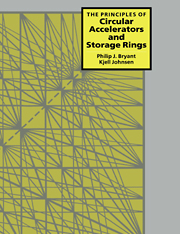Book contents
- Frontmatter
- Contents
- Foreword
- Coordinate system
- Symbols
- Useful Constants
- 1 Introduction
- 2 Basic concepts and constant-gradient focusing
- 3 Alternating-gradient focusing
- 4 Parameterisation of the transverse motion
- 5 Imperfections and resonances
- 6 Chromaticity
- 7 Longitudinal beam dynamics
- 8 Image and space-charge forces (transverse)
- 9 Coherent instabilities
- 10 Radiating particles
- 11 Diagnosis and compensation
- 12 Special aspects of circular colliders
- Appendix A Transverse particle motion in an accelerator
- Appendix B Accelerator magnets
- Appendix C Closed orbits
- Appendix D Phase equation
- Appendix E Vlasov equation
- References
- Index
1 - Introduction
Published online by Cambridge University Press: 11 November 2009
- Frontmatter
- Contents
- Foreword
- Coordinate system
- Symbols
- Useful Constants
- 1 Introduction
- 2 Basic concepts and constant-gradient focusing
- 3 Alternating-gradient focusing
- 4 Parameterisation of the transverse motion
- 5 Imperfections and resonances
- 6 Chromaticity
- 7 Longitudinal beam dynamics
- 8 Image and space-charge forces (transverse)
- 9 Coherent instabilities
- 10 Radiating particles
- 11 Diagnosis and compensation
- 12 Special aspects of circular colliders
- Appendix A Transverse particle motion in an accelerator
- Appendix B Accelerator magnets
- Appendix C Closed orbits
- Appendix D Phase equation
- Appendix E Vlasov equation
- References
- Index
Summary
Nuclear physics research was the birth-place of charged-particle accelerators and for many decades their main ‘raison d'être’. This has given them a somewhat specialised and academic image in the eyes of the general public and indeed accelerators and storage rings do provide an extremely rich field for the study of fundamental physics principles. However, this academic image is fast changing as the applications for accelerators become more diversified. They are already well established in radiation therapy, ion implantation and isotope production. Synchrotron light sources form a large and rapidly growing branch of the accelerator family. The spallation neutron source is based on an accelerator and there are many small storage rings for research around the world relying on sophisticated accelerator technologies such as stochastic and electron cooling. In time accelerators may be used for the bulk sterilisation of food and waste products, for the cleaning of exhaust gases from factories, or as the drivers in inertial fusion devices.
During the first third of our century, natural radioactivity furnished the main source of energetic particles for research in atomic physics. Let us mention a famous example. At McGill University, Montreal, Canada, in 1906, Rutherford bombarded a thin mica sheet with alpha particles from a natural radioactive source. He observed occasional scattering, but most of the alpha particles traversed the mica without deviating or damaging the sheet.
- Type
- Chapter
- Information
- Publisher: Cambridge University PressPrint publication year: 1993



